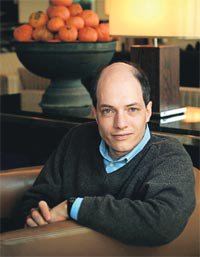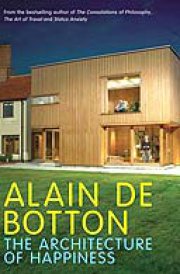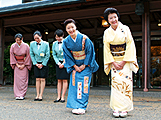Graham Reid | | 5 min read

As someone with an amateur’s enthusiasm for architecture and design, I was disappointed to miss the recent talk by the English essayist Alain de Botton, author of the popular book The Architecture of Happiness.
I call him an essayist because that is what he is: as someone who travels often and writes about it I had previously enjoyed his provocative little book The Art of Travel, and had flicked the pages of his The Romantic Movement. But oddly enough had not seen any of his popular television programmes.
And I note that is the second time I have used the word “popular” about AdB, because he is a populariser. And perhaps appealing to popular taste.
This is something often frowned upon by academics or those out to protect their own hallowed turf -- and design critic Douglas Lloyd Jenkins’ slightly sniffy and derisive article about AdB’s visit in the Listener (There’s a Thought, July 1-7) unfortunately had the whiff of both.
DLJ also made some spurious comparison with the Canadian alt.folk singer Martha Wainwright who was in town around the same time: something about her being more credible because she had a smaller audience and wasn’t here to flog some product, unlike AdB who was clearly here to push his book.
Well, I hate to be the bringer of bad tidings but believe me -- as someone who worked in the media end of the music business for many years -- my educated and somewhat pragmatic guess is Martha, her manager and her record company were just as keen to flog off albums as AdB was to sell his book. It’s just a matter of scale and marketing.
What was more worrying about DLJ’s comments was the haughty tone he adopted, as if what AdB had to say was unworthy because he wasn’t An Architect.
By that logic most critics wouldn’t be writing because they don’t actually practice the craft they are considering. Does every theatre critic have to be an actor? Every music writer be in a band or playing second fiddle in an orchestra?
This is nonsense of course and on reading DLJ’s piece -- and I read all his columns, I usually enjoy his viewpoint -- I was left with the uncomfortable feeling that this was driven by envy, condescension (“The London charmer”) and arrogance.
Conceding (seemingly reluctantly) that AdB was a “gifted amateur”, DLJ went on to note his lack of architectural credentials.
To which I -- as a very ungifted amateur -- have to say: so what?
 AdB has written an interesting, thought provoking and sometimes insightful book on architecture -- and that’s enough for me. Letters after his name which don’t include “Arch” somewhere don’t concern me.
AdB has written an interesting, thought provoking and sometimes insightful book on architecture -- and that’s enough for me. Letters after his name which don’t include “Arch” somewhere don’t concern me.
As with Tom Wolfe -- whose From Bauhaus to Our House a few decades ago was equally enjoyable, equally flawed, but informative and opinionated -- I take AdB for what he is: a populariser and essayist in the tradition of Kenneth Clark, J. Bronowski and Stephen Jay Gould.
AdB’s book can rightly be skewered however, and the other night I was reading again his passages on Huis Ten Bosch, a mini-Holland which has been built just outside Nagasaki.
I have been to Huis Ten Bosch and wrote about it in my own book Postcards From Elsewhere. But what struck me about AdB’s encounter with this odd place is how he characterises it, then extrapolates something about Japan from it.
Huis Ten Bosch may well be a theme park and somewhat surreal -- you don’t often see windmills, horse drawn carts and restful canals in Japan -- but it is something more than that: it is built as an eco-friendly town (yep, unlike Disneyland real people actually live there) and rather than being an utter dislocation of no fixed ethos it is a salute/homage/whatever you want to call it to the fact that the Dutch were the earliest traders in this region and enjoyed access to Japan at a time when no other Western nations did.
The Dutch were enormously influential in this region a few centuries ago.
Okay, maybe it is drawing a long bow to justify its existence on those grounds -- but AdB doesn’t acknowledge this aspect at all: he’d have you believe it was as much an artificial conceit as Disneyland. It is strange, unusual and unexpected, but it’s not quite a Disneyland. As far as I could tell it wasn’t the ugly face and advance guard of Dutch cultural and economic imperialism.
Further on however AdB takes a friend’s advice and heads off to what sounds like a lovely ryokan, the traditional travellers inn. Here enjoys the cliches of Japan: the ryokan is a wooden pavilion, has paper walls and sliding doors, there is a receptionist in a kimono, an onsen (open bath), and he “fell asleep to the sound of water pursuing a path down the mountain side over smooth flat ancient volcanic stones”. 
I’ve had much the same experience myself and it is lovely. Of course.
Then AdB bemoans the fact that the concept of the ryokan has not been translated into modern Japan.
Well, the charms he enjoyed belonged to a simpler time -- a rural society -- and in a sense the notion, if not the enchanting aspects of a travellers inn, certainly exist in Japan. They are called business hotels and, like it or not, they do all the things the ryokans do (albeit with somewhat less archaic sweetness).
They are functional, tidy and economic in their use of space, there is no excess clutter by way of fittings, and you don’t stay in them long. When you depart you leave no footprint of your presence, just as happens at the charming ryokan with its running water and sliding doors and woman in a kimono.
Ryokans -- and they exist in cities not just in the countryside -- just provide simple and cheap accommodation (like a business hotel) for those travelling around.
Oddly enough AdB then goes on to note his annoyance at the traditionally styled village of Poundberry near Dorchester which, while “capturing the spirit of country life in the 18th century [was] ultimately maddening for its disconnection from the psychological and practical demands of contemporary society“. And it “resembled an ancient relative”.
And the lovely ryokan didn’t?
He also says he saw a traditional little shrine on a rooftop amidst air conditioners in Kyoto which “looked as if it had been dropped from the air to answer certain inner needs left unmet by modern architecture”.
I suspect it was faith rather than the failing of architecture which put that shrine there.
When I read this by AdB about Japan I remembered what the very wise Alan Booth, a long-time resident of Japan, once observed: “More thorough nonsense must be spoken and written about Japan than about any other comparably developed nation”.
Booth noted how travellers there romanticise their experience, and Japan itself (the language which sounds like the twittering of birds, the impenetrable but exotic calligraphy etc).
I fear that is exactly what AdB does about ryokans.
Maybe if he’d stayed in some of the inner-city ryokans I have -- with their views across rooftops and televisions aerials, and their cramped little rooms and surly owners -- he might not have been so seduced by the romance of the travellers inn.
It is harder to sleep with the sound of a leaking tap.
This is a modified version of a column which first appeared at the website of the design and architecture firm Freestyle Design, www.freestyledesign.co.nz in late 2006







post a comment